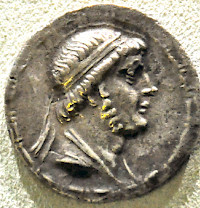Arsaces VII, Phraates II
Arsaces VII, Phraates II: Arsacid king of the Parthian Empire (r.132-127).

Mithradates I the Great had established the Parthian Empire in what is now called Iran and Iraq. However, he had suffered a strokenote and his brother Bagayasha had acted as his substitute. In the final weeks of 132 BCE, the conqueror died and was succeeded by his young son, Phraates II. His mother Ri'nu appears to have acted as regent.note
At the same time, the Seleucid Empire, which had been divided by inner conflicts since the loss of its eastern satrapies, had come to rest under Antiochus VII Sidetes (r.138-129). He decided to reconquer the eastern satrapies and in 130, he defeated the Parthians thrice and expelled them from Babylonia, pushing them back across the Zagros Mountains, following them into Media and wintering in Ecbatana.note After the winter, he demanded full restoration of all Seleucid territories in the east, but Phraates refused; attacking the westerner, the Parthians defeated him. Antiochus committed suicide on May 20, 129. Phraates sent back the dead body in a silver coffin.note
In Antiochus' company had been several relatives, the children of Demetrius II Nicator, the Seleucid king who had in 141-139 lost the eastern satrapies to Mithradates and had been held captive for some time. Phraates took the children captive and of these he married princess Laodice, giving him a claim to the Seleucid throne. This appears to have been a serious plan, because Phraates also released his new father-in-law Demetrius, who returned to Antioch, married to Phraates' sister Rhodogyne. He would rule for several years over the Seleucid rump state in Syria and Cilicia, but before he could make his Parthian son-in-law/brother-in-law his heir, news came that Phraates had been killed in action in a war against nomadic invaders from the Central Eurasian plains (127).
Phraates was briefly succeeded by Bagasis (r.127-126), who was almost immediately succeeded by Artabanus I (r.126-122). Demetrius died one year after. His successor on the Seleucid throne was the other child Phraates had taken captive: Seleucus V (r.126-125).
Note
The chronology of the Arsacid kings of the Parthian Empire is less well-understood than, for example, the sequence of Seleucid and Ptolemaic kings or the emperors of Rome. This information is based on the researches by G.R.F. Assar, as published in "Iran under the Arsakids, 247 BC – AD 224/227" in: Numismatic Art of Persia (2011).